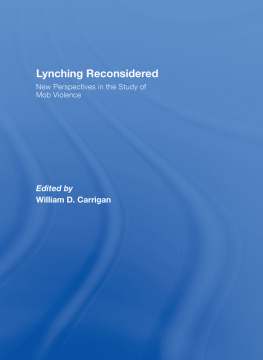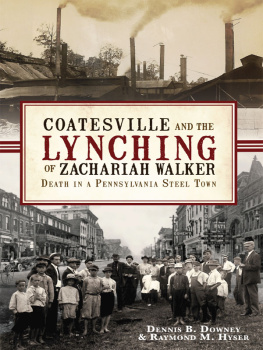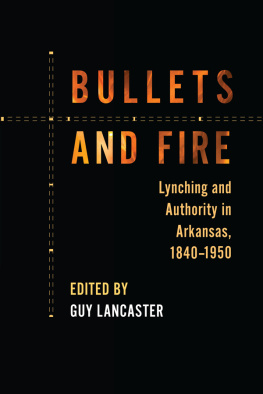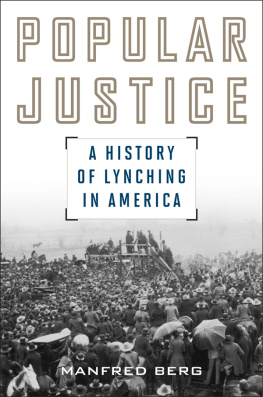Anatomy of a Lynching
Anatomy
of a Lynching
The Killing of Claude Neal
Updated Edition
JAMES R. McGOVERN
With a New Foreword by MANFRED BERG
Louisiana State University Press
Baton Rouge
Any mans death diminishes me, because I am involved in Mankinde.
John Donne
Devotions, XYII
Published by Louisiana State University Press
Copyright 1982 by Louisiana State University Press
All rights reserved
Manufactured in the United States of America
Designer: Albert Crochet
Typeface: Trump Medieval
Typesetter: Graphic Composition, Inc.
The author wishes to thank the Alabama State Archives, Montgomery, for permission to quote The Confession of Claude Neals and the Florida State Archives, Tallahassee, for permission to quote the letter from M. B. Collie to Governor David Sholtz, November 12, 1934.
LIBRARY OF CONGRESS CATALOGING IN PUBLICATION DATA
McGovern, James R.
Anatomy of a lynching : the killing of Claude Neal / James R. McGovern ; with a new foreword by Manfred Berg. Updated edition.
pages cm
Includes bibliographical references and index.
ISBN 978-0-8071-5425-0 (pbk. : alk. paper) ISBN 978-0-8071-5427-4 (pdf) ISBN 978-0-8071-5426-7 (epub) ISBN 978-0-8071-5428-1 (mobi) 1. Neal, Claude, -1934. 2. LynchingFlorida 3. LynchingUnited States. I. Title.
HY6465.F6M35 2014
364.1'34dc23
2013020808
The paper in this book meets the guidelines for permanence and durability of the Committee on Production Guidelines for Book Longevity of the Council on Library Resources. 
Contents
Figures
Foreword to the Updated Edition
Anatomy of a Lynching after Thirty Years
In late october 1934, Jackson County, in northwestern Florida, became the scene of a lynching that evoked shock and disbelief all over the United states not only because of its unfathomable cruelty but also because it gave the lie to widespread assumptions that, at long last, mob justice was disappearing even from the Deep south. a group of vigilantes abducted Claude Neal, a twenty-three-year-old black farm laborer accused of raping and murdering Lola Cannidy, a young white woman, from a jail in Brewton, Alabama, where Florida authorities had brought the prisoner for safekeeping. The vigilantes easily outwitted the jailers and drove Neal back to Marianna, Florida, the scene of his alleged crime. After their return, Neals captors tortured their victim for hours, reportedly forcing the black man to swallow his own genitals. Eventually they shot Neal dead, tied his body to a car, dragged it through the streets, and then hanged it from a tree opposite the courthouse. After the lynching, a raging mob attacked African Americans on the streets of Marianna until the National Guard halted the rioters.
In Anatomy of a Lynching, first published in 1982, historian James R. McGovern (1928-2012) called the killing of Neal one of Americas last classic lynchings (15). Indeed, the Marianna mob murder included almost all of the key elements that Americans in the first half of the twentieth century had come to associate with the practice of lynching. Consider the site of the incident: the south was where more than 80 percent of all lynchings occurred. According to the statistics kept by civil rights organizations, African Americans represented a staggering 83 percent of all southern lynch victims, amounting to roughly 3,250 fatalities between the 1880s and World War II.
McGovern conceived his book about the story of Neals death as a case study that, he hoped, would facilitate understanding, with the aid of social and psychological theory, of the phenomenon of lynching itself (15). Following a brief introduction to the most influential scholarly interpretations of mob violence, the author provides the reader with an in-depth portrait of life and race relations in Jackson County, an isolated and poverty-stricken Deep south community in the Florida Panhandle. Based on meticulous archival research, including the records of the National Association for the Advancement of Colored People (NAACP) and the Association of southern Women for the Prevention of Lynching (AsWPL), newspaper accounts, and oral history interviews, Anatomy of a Lynching carefully reconstructs the events that unfolded in the fall of 1934: the murder of Cannidy, Neals arrest and odyssey through the jails of northwestern Florida and southern Alabama, his abduction and death, the mutilation of his body, and the ensuing riots in Marianna. Although the Neal case left a more detailed record than most other lynchings, open questions remain, especially if Neal and Cannidy had entertained an illicit sexual relationship or if he had indeed murder the young woman. As a conscientious historian, McGovern notes that the evidence against the suspect was less than compelling and mentions allegations that the black man and the white woman were secret lovers but otherwise refrains from speculation. Even if there were conclusive answers to these questions, they would not tell us much about the deeper roots of lynching in the first place.
Instead McGovern focuses on the local and national reactions to the case. His account of the former bears no surprises for readers familiar with the history of lynching. Local elites blamed the mob violence on outsiders but at the same time justified the need for lynch law to protect white women from black rapists. Although Neals murderers were probably well known to many local residents, the authorities undertook no serious investigation. McGoverns assessment of the national reactions to the events in Marianna is, however, more uplifting. The NAACP utilized the case to reinvigorate its campaign for a federal antilynching law, and although these efforts failed, the author argues that the outrage the incident provoked all over the United states hastened the demise of lynching as a public ritual, serving as a catalyst for southern modernizationan argument not all reviewers found persuasive.
In his brief concluding chapter McGovern places his case study into a broader historical and theoretical perspective by drawing parallels between Jews in Nazi Germany and blacks in the Jim Crow south. In doing so, he examines psychological theories of child rearing and rape that might help explain the mindsets of both lynchers and their victims. The comparison between lynching and other manifestations of violence led him to what he called a hypothesis with broad implications: men become violent when they feel justified to do so and when they do not meet effective opposition to their pretensions (155). Not surprisingly, McGoverns conclusions evoked critical remarks from reviewers. One sociologist thought his use of social psychological theory lacked analytical rigor, arguing that his hypothesis did not go beyond a truism.
Despite some criticism on specific aspects of the book, Anatomy of a Lynching received mostly favorable reviews and rightly so. Reviewers praised McGoverns graceful style, his gripping narrative, and his detailed research. Leading historians of southern race relations, including Ray Arsenault, Dan T. Carter, and David Colburn, greeted the book as a welcome contribution to an issue that has not received enough scholarly attention, as Colburn put it. Although McGoverns interpretation echoes the antilynching activists of the 1930s, especially their faith that the economic and cultural modernization of the south would solve the problems of lynching and racism generally, his use of new social psychological theories represented a fresh and provocative approach at a time when scholarly interest in lynching was just getting off the ground again.
Whereas lynching and mob violence had elicited numerous studies by scholars and antilynching activists from the 1880s to the early 1940s, another four decades would pass before historians began taking a closer look at these topics in the late 1970s and early 1980s. McGovern does not discuss the reasons for this hiatus other than citing a scarcity of source materials that might have discouraged scholars to engage the subject. Yet, in light of the impressive research conducted by historians in subsequent years, this explanation is hardly satisfactory. Arguably, a collective desire to forget about a painful and embarrassing historycertainly not a unique American phenomenon, as this German historian will readily attestwas more important than a lack of documents. Although McGovernwho was born in Pennsylvania and received his academic training in the North before accepting a professorship at the University of West Florida in Pensacoladid not elaborate on his personal motives and experiences in investigating southern mob violence, he related in his preface that Jackson County was still sensitive about the Neal lynching (xxv). Aided by his research assistant Walter T. Howard, who later published a book of his own about extralegal violence in Florida, such criticism sounds gratuitous, given that the author faced a choice between confidential interviews and no interviews at all.
Next page







